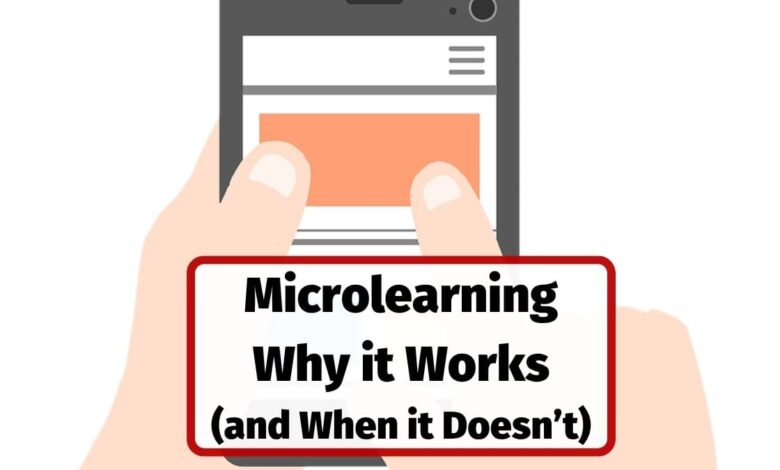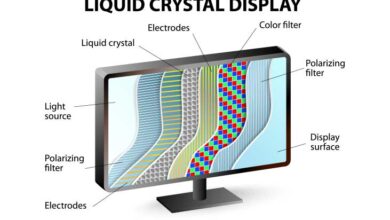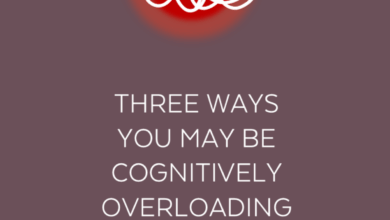Why Microlearning Works (& When It Doesn’t) Practical Guide


Microlearning. You might have started to hear this term more and more as you sit through training sessions, work meetings, or as you’ve looked into workplace training design and planning. Or perhaps it’s a new term for you?
It’s everywhere in the L&D world right now and depending on who you ask, it’s either a revolution or just another trend in workplace training.
But what’s really behind the idea of microlearning? Is it effective? And just as importantly, when isn’t it?
In this post, let’s explore why microlearning works so well in certain training situations. Let’s look in plain terms, what makes it work, when it tends to fall flat, and how to use it meaningfully.
What Is Microlearning (Without the Jargon)?
In simple terms, Microlearning is short, targeted learning that solves a specific problem or delivers a single idea. It’s not just about brevity: It’s also about purpose.
Microlearning is training that is brief and to the point, but purposeful and useful, and gives a definite and clear lesson.
If you’ve ever Googled how to do something in Excel, watched a 2-minute tutorial, and got back to work, then you’ve experienced microlearning in action.
Real examples:
- A visual cheat sheet for remembering key coaching questions
- A short scenario quiz on customer service etiquette
- A podcast snippet explaining GDPR basics — just enough to keep you out of trouble
Good microlearning doesn’t try to do everything. It does one thing well.
>> Learn more examples of what microlearning is.
Top 5 Reasons Microlearning Works
There’s real science behind why microlearning helps people learn, and it’s not just about people’s attention span, so let’s take a look at 5 key reasons it works.
1. It Gives Your Brain a Break
Let’s be honest. No one’s brain is wired to absorb three hours of training in one go. We simply cannot focus for such a long period of time.
Microlearning works because it respects how people naturally process information.
Small, manageable chunks = less mental fatigue. This aligns with cognitive load theory, which shows that most of us find it easier to learn when we are presented with information as digestible units.
2. It Leverages Spacing
Spacing out learning beats cramming, and this is backed up by numerous studies in the area of cognitive science research.
Microlearning encourages repeat touchpoints, a proven method for improving learning retention over time.
3. It’s Fast Help When You Need It
Imagine trying to remember a policy mid-task and having to dig through a 50-PowerPoint slide deck. Or think about when you use YouTube to quickly learn how to do a specific task, and you find the answer and learn in just a few minutes.
Microlearning offers quick, accessible reminders that support real work, not slow it down.
This is a perfect example of just-in-time learning, providing the right information exactly when it’s needed, directly in the workflow.
4. It Helps Build Better Habits
Let’s say you’re trying to get managers to give regular feedback, not once a quarter, but weekly.
This is about creating a behavior shift, rather than just filling a knowledge gap.
Microlearning can help by delivering small, consistent nudges, such as weekly prompts, short “how-to” videos, or real-life scenarios.
These prompts help to gently reinforce the habit over time. It’s not one big workshop; it’s a slow drip of reminders that actually stick.
This point can be confusing, so let me give you one example:
Imagine you’re trying to help team leads get better at running 1:1s with their direct reports. Instead of a big 2-hour training (which they’ll forget half of), you could send them:
- A short video: “3 Questions Great Managers Ask in 1:1s”
- A quick scenario: “What would you do if your team member shut down during feedback?”
- A one-slide checklist for use during their actual meeting
These are small, purposeful pieces of content delivered regularly that help build a new habit.
5. It Makes Continuous Learning Feel Doable
Many of us want to learn, but we just do not want to sit through a 90-minute workshop to do it.
Microlearning makes daily, snackable learning feel less intimidating and more achievable.
Common Mistakes with Microlearning: When Microlearning Doesn’t Work
Let’s not pretend microlearning solves everything. There are very real limits.
1. Big Topics Need Big Space
You cannot teach someone how to lead a team or navigate complex ethical issues in five-minute bursts.
Some topics need time, reflection, and dialogue.
Microlearning can support, but it cannot replace, these deeper learning experiences.
2. Disconnected Content Creates Confusion
If learners are jumping between micro-units without knowing how they connect, it just feels like noise.
There needs to be a structure, even if it’s behind the scenes.
3. Short Doesn’t Equal Engaging
Short content can still be boring if not done well!
If your microlearning is just a static PDF or a dry voiceover reading bullet points, learners will click away just as fast as with a long course.
4. It’s Not a One-Tool-Fits-All
We’ve seen some large organisations try to use microlearning as a catch-all solution, trying to solve complex training needs with a handful of videos.
That’s like using duct tape for everything. Sometimes you need something more robust.
5. Some Learners Crave Depth
Not every learner is looking for quick tips. Some learners want to go deeper.
If you only serve micro-content, you risk frustrating the curious and motivated, the very people who want to grow most.
In essence, it is about understanding the different learner types and the basics of pedagogy. One useful model is Malcolm Knowles’ Adult Learning Theory, which outlines principles like self-direction, relevance, and the value of experience—all critical for designing microlearning that resonates with adult learners.
Making Microlearning Actually Work (Without Overthinking It)
If you’re building microlearning packages or considering it, here are a few ground rules to get more impact with less noise:
1. Start with One Job to Be Done
Each microlearning piece should answer one clear question or teach one actionable skill.
If the microlearning unit is focused on doing five things, then it’s not micro anymore.
2. Mix It Up
Video is great, but it’s not the only option.
Use short podcasts, infographics, interactive exercises, and even well-designed PDFs. Variety helps learners stay engaged.
3. Design for Mobile First
Most learners will access content on their phones.
Keep it clean, quick to load, and easy to tap through on a coffee break.
4. Put It Where the Work Happens
The best microlearning is invisible.
Job aids built into tools, pop-ups during workflow, and quick prompts in Teams or Slack—these all meet learners where they are.
These are examples of performance support tools, resources designed to guide behavior in the moment of need. For example, a quick-reference checklist of performance appraisal questions can serve as a real-time aid during 1:1s or formal reviews.
5. Track What Matters
Forget vanity metrics.
What behavior changed? What question gets asked less? What mistake stopped happening? Measure outcomes, not just clicks.
Too many L&D teams still rely on vanity metrics, spending time, for example, on the number of modules completed or the number of clicks. These stats often do not reflect true learning outcomes.
Instead, focus on behavioral change and knowledge retention. As Training Industry explains, microlearning is most effective when it’s tied to measurable business performance and learner needs, not superficial stats.
Final Thoughts
Microlearning isn’t a magic solution, but it is incredibly useful when done well. It’s flexible, respectful of people’s time, and a great fit for today’s fast-moving workplaces.
Microlearning is most powerful when it supports your overall digital learning strategy, rather than standing alone.
Just remember: it’s a tactic, not a strategy. Use it to support bigger learning goals, not replace them. And always ask: is this helping someone do something better, or just filling a content quota?
Further Resources
In addition to more microlearning guides, you might be interested in the Employee Burnout Microlearning package below:


>> Going Live in July 2025 – Employee Burnout Microlearning downloads




